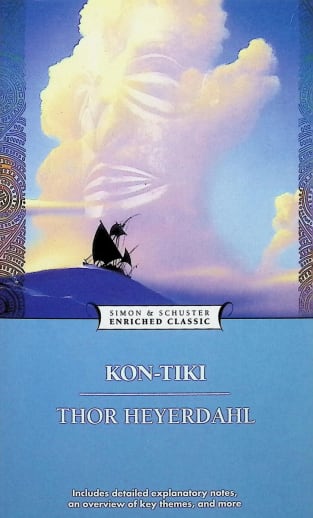This classic by Thor Heyerdahl tells the remarkable true story of Heyerdahl and his small five-man crew that sailed from South America to the Polynesians in 1947. The remarkable thing about this voyage is that it was completed on a nine-log raft with no modern conveniences used to construct or sail. Heyerdahl was trying to prove that Polynesians may have originated in South America and then sailed 4,300 miles across the Pacific Ocean to settle hundreds or thousands of years ago. He was intrigued by Polynesian folklore about a mythical hero named Kon-Tiki who came from distant lands to start a civilization and decided to prove his theory that ancient people easily could have sailed across oceans to migrate. The three months the crew spent in the open water is full of exploration, storms, whales, sharks, and more. This exciting story is so full of daring, courage, and adventure that it's almost hard to believe it's a true story. A 48-page readers' supplement is included in the middle of the book that gives an ultra-condensed version of the story and includes black and white photographs from the actual voyage. A fascinating book and great library builder. 240 pgs, pb. ~ Rachel
Kon Tiki
SKU
034110
ISBN
9780671726522
Grade 8-AD
These icons are designed to help you quickly understand and learn important information about our products.
Teaching Method
Traditional
Teacher-centered curriculum commonly used in classrooms that may include a text, teacher manual, tests, etc.
Charlotte Mason
A methodology based on the work of a 19th century educator who maintained that children learn best from literature (Living Books), not textbooks.
Classical
A methodology based on the Latin Trivium (three stages of learning), including the grammar stage (memorization and facts), logic stage (critical thinking), and rhetoric stage (developing/defending ideas).
Unit Study
A thematic or topical approach centered around one topic that integrates multiple subject areas.
Montessori (Discovery)
A methodology based on the work of a 20th century educator that emphasizes student and sensory-driven discovery learning and real-life applications.
Other
Other methodologies
Religious Content
Secular
Contains content contrary to common Christian beliefs (i.e. evolution).
Neutral
Avoids religious or theoretical topics or presents multiple viewpoints without preference.
Christian/Religious
Faith-based or including instructional religious content.
Learning Modality
Auditory
Learns through listening, talking out loud or reading out loud.
Visual
Learns through seeing, prefers written instructions and visual materials.
Kinesthetic/Tactile (Hands-On)
Learns through moving, doing and touching.
Multi-Sensory
Curriculum that employ a variety of activities/components.
Presentation
Sequential
Curriculum progresses through well-defined learning objectives. Emphasizes mastery before moving to the next topic.
Spiral
Topics and concepts are repeated from level to level, adding more depth at each pass and connecting with review.
Conceptual/Topical
Focus is on the “why,” often with a unifying concept as well as specific skills; coverage may be broader.
Teacher Involvement
Low Teacher Involvement
Student-led materials; parent acts as a facilitator.
Medium Teacher Involvement
A mix of teacher-led time and independent student work.
High Teacher Involvement
Teacher-led lessons; may utilize discussions, hands-on activities and working together.
Additional Materials Required
No other materials needed
Everything you need is included.
Other Materials Required
There are additional required resources that are a separate purchase.
Other Materials Optional
There are additional resources mentioned or recommended but are not absolutely necessary.
Consumable
Consumable
Designed to be written in; not reusable.
Non-Consumable
Not designed to be written in; reusable.
Our Price
$8.99 $8.99 $6.75
Rainbow Savings: $2.24
Description
Details
| Product Format: | Softcover Book |
|---|---|
| Grades: | 8-AD |
| Brand: | Simon & Schuster |
| Author: | Thor Heyerdahl |
| ISBN: | 9780671726522 |
| Length in Inches: | 6.8 |
| Width in Inches: | 4.1 |
| Height in Inches: | 1 |
| Weight in Pounds: | 0.3395 |
| Edition: | 35th Edition; Reprint; Illustrated |
| Pages: | 256 |
| Publication Date: | 5/1/1990 |
Videos
Reviews

